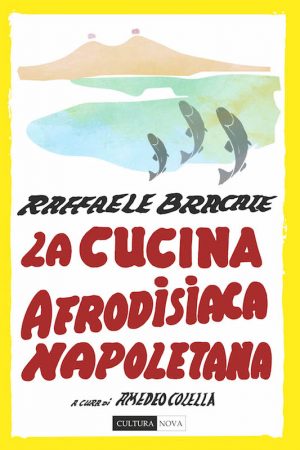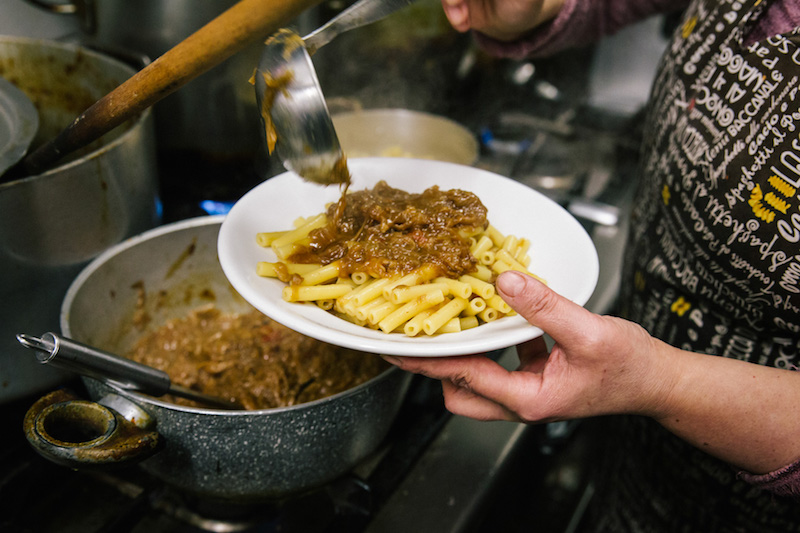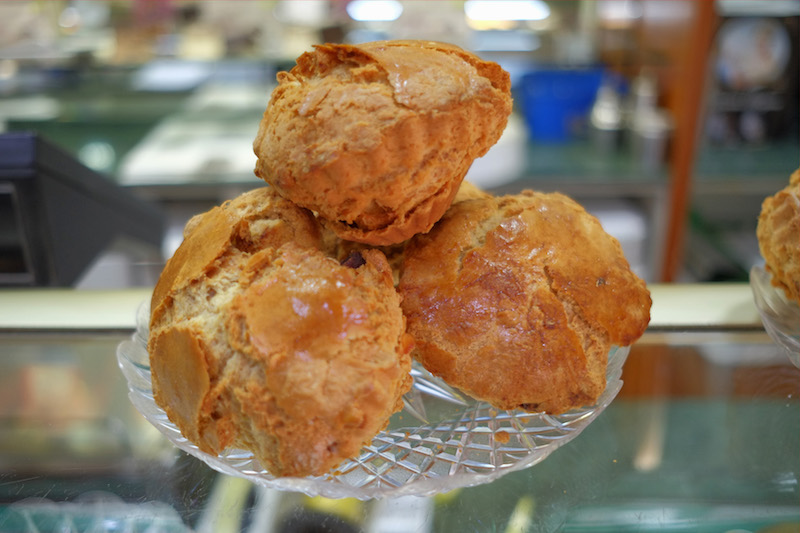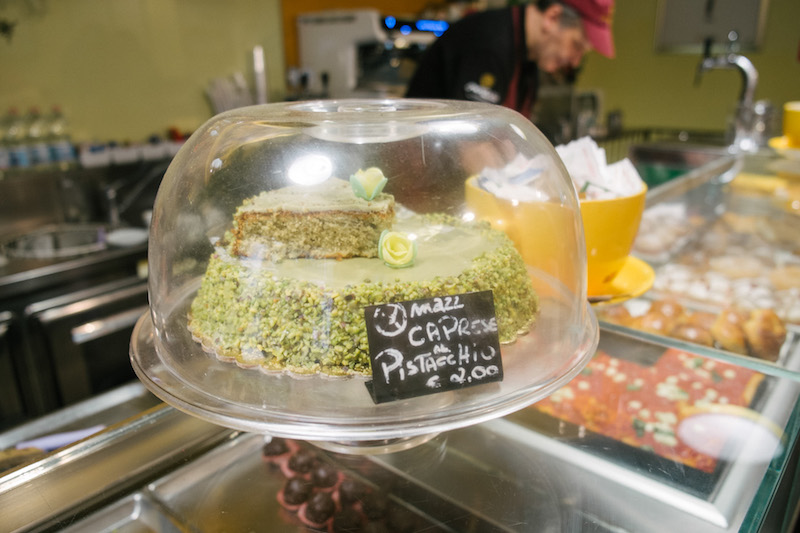We can't find the internet
Attempting to reconnect
Something went wrong!
Hang in there while we get back on track
Search results for "Amedeo Colella"
Naples
Mimì alla Ferrovia: Innovation at a Temple of Tradition
On a recent visit to the market of Sant’Antonio Abate, a pilgrimage site for fresh produce, we made friends with Salvatore, a young Neapolitan chef who was buying fruit and vegetables for his restaurant. We thought nothing of it until we bumped into him again, this time when he was buying fresh bluefish, the symbol and pride, he told us, of his restaurant. Our curiosity piqued, we asked where he worked. Mimì alla Ferrovia, he told us, a name we immediately recognized – it’s one of the custodians of Neapolitan gastronomic orthodoxy. And Salvatore Giugliano, an innovative young chef of 27, is now at the helm of this historic restaurant.
Read moreNaples
The Water Banks of Naples: H2Oh!
Naples has a lot of iconic eateries and shops, but one of the lesser-known city icons is the kiosk of the fresh-water-seller. Scattered throughout the city, the banks of the acquafrescai – some of which are very famous – sell various mineral waters and refreshments. These kiosks were born to provide relief in the summer months, and for that reason they are widespread in other southern Italian cities, particularly in the Sicilian cities of Palermo, Catania and Syracuse, where the coolness of a granita, a semi-frozen dessert made from sugar, water and various flavorings, counters the oppressive heat.
Read moreNaples
Pasticciando: Cherry Bombs
Dozens of urban legends swirl around the city of Naples – strange stories repeated a thousand times that, somewhere along the line, become credible. One of those urban legends concerns biscotti all’amarena, or black cherry cookies: people often say that they are made from day-old cakes. To create this typical Neapolitan sweet, bakers chop up pan di spagna (sponge cake) – the bit that is supposedly reused – and then mix it with black cherry syrup, cocoa and cinnamon. The mixture is then covered with a short-crust pastry shell and baked as a loaf, after which they’re cut into small rectangles.
Read moreNaples
Antica Baccaleria Porta Capuana: New Tricks for an Old Fish
“Mamma mia!” exclaims our Californian friend, as he tastes a slice of cod carpaccio for the first time. Better yet, let’s call this dish, made by one of the oldest fish shops in Naples, Norwegian stockfish sashimi. We are in Porta Capuana, and Vincenzo Apicella is carefully slicing dried fish (stockfish is an unsalted fish preserved only by cold air and wind) that has been rehydrated. He seasons the very thin fillets simply, with the juice of a fragrant Sorrento lemon, and serves them together with Sicilian green olives. The dish is proof, if it was needed, that good food tastes best when it is prepared as simply as possible.
Read moreNaples
Spring Surprises: In Naples, Love Is In the Air (and on the Plate)
Spring means a rebirth, a restart and, for Catholics, a resurrection. The sunnier weather and warmer temperatures are invigorating, allowing you to shake off the long and cold winter. It’s one of the best mood boosters out there. But the season alone doesn’t fully awaken, ahem, everything. If you’re looking to arouse your sensuality, you can always count on Naples’ notoriously stimulating, almost erotic gastronomy. Yes, we’re talking about aphrodisiacs. The concept comes from our Greek ancestors, who believed that certain foods were capable of improving sexual performance and accordingly named them after Aphrodite, the goddess of love, beauty and, perhaps most importantly, pleasure.
Read moreNaples
Trattoria Malinconico: In the Court of the Lunch King
If you were to ask me what my ideal lunch is, I would answer without hesitation: paccheri alla Genovese with a large piece of stewed veal shank for the first course, followed by a big ball of buffalo mozzarella (preferably from Tenuta Vannulo, an organic buffalo dairy in Capaccio) with eggplant parmigiana on the side. The backbone of this perfect meal is the Genovese, a simple yet miraculous sauce made of meat (veal, beef or pork) and a heap of onions (red or white). Even those who say they don’t like the taste of onions are forced to recant once they taste the Genovese (after hours spent simmering with the meat, the tenderized and translucent onion slivers have no trace of the astringent smell or bite of raw onions).
Read moreNaples
Pizzeria e Trattoria Vigliena: Spaghetti with Clams, A Primer
One day, or so the story goes, a group of tourists asked an elderly priest in Naples which churches were really worth visiting. The priest replied, “There are many churches, but have you tried the spaghetti with clams?” Even a man of God recognizes the sacred bond established between two people sharing a plate of spaghetti with clams in a Neapolitan trattoria. So we consider it our moral duty to advise you how to order your spaghetti with clams and where to eat it.
Read moreNaples
Friggitoria Vomero: Where Every Day Is Fry Day
There’s a saying in Naples: “Anything fried is good, even the soles of shoes.” You may laugh, but we wholeheartedly agree ¬¬– frying may have a bad rap in some parts of the world, but it can add a richness and flavor to any type of food (and, perhaps, even footwear). Think of a dull, bland zucchini or eggplant; when fried right, it becomes a pleasure. We normally get our fried fix by ordering a cuoppo, a paper cone filled with crispy morsels. This symbol of Neapolitan fried street food is our typical mid-morning snack – while going about our morning errands, we munch on the small bites of fried deliciousness that are swaddled in the plain brown paper.
Read moreNaples
Carnival of Sweets: Sanguinaccio, Chiacchiere and Savoiardi
Sweets can stir up feelings and evoke memories of particular times of the year in a way that other foods can’t. This is particularly true in Naples, where there is a dessert for every holiday: struffoli (small fried dough balls doused in honey) and cassata (sponge cake with ricotta and candied fruit) call to mind lively and colorful Christmas celebrations, while the pastiera (a cake filled with ricotta cheese, eggs and custard) reminds us of the exuberance of Easter. While those sweets are certainly indulgent, they don’t hold a candle to chiacchiere (a sweet crispy pastry sprinkled with powdered sugar) and sanguinaccio (black chocolate pudding), which immediately bring to mind the most eccentric and unruly party of the year: Carnival.
Read moreNaples
Cibi Cotti Nonna Anna: The French Connection
Neapolitan cuisine is an impure thing, the result of culinary influences from every part of the old continent. One of the most famous dishes this cross-pollination has produced is the Neapolitan potato gattò, a potato tortino rustico (a tall, square cake) with layers made of mozzarella, scamorza, ham, salami and more. A baroque dish, this gattò transforms the simple potato into a true miracle of gastronomy. The word “gattò” (not to be confused with “gatto” without the accent, which means “cat” in Italian) is the Neapolitanization of the French “gateaux” (cakes). But the Neapolitan potato gattò recalls the French gateaux only in form – taste-wise, it’s very far from a sweet French cake.
Read moreNaples
Best Bites 2017: Naples
In 2017, the Naples food scene took many steps forward by taking a step back: Restaurants resurrected ancient ingredients and most importantly, in a city famed for its pizza and pasta, old flours native to southern Italy made a comeback. The renewed interest in quality can be observed in all corners of this great city, from fast food joints to starred restaurants. My favorite eats of 2017 centered on those spots that attach importance to the basics, serving Neapolitan cuisine made with only the finest traditional ingredients. But it wasn’t the food alone that hooked me: The special people who manage these places played as large of a role, if not larger, in drawing me back to their tables time and time again.
Read moreNaples
Ciro Pace Bakery: Fathers and Sons
Sometimes we crave salty, sometimes sweet. But there are those inexplicable moments when we want both at the same time. At these moments of mixed signals, we make our way to Ciro Pace Bakery on Via Nazionale for a rustico soffiato. This perfect mix of salty and sweet is made of short pastry and pâte à choux (cream puff dough), and stuffed with ham and cheese. Its lower half recalls the typical Neapolitan rustico (a savory cake), while the upper part resembles a huge hat (this is where the pâte à choux dough comes in) – the truly innovative feature of this pastry.
Read moreWorldwide
Carmine the Wizard: A Vendor for All Seasons
Naples is a city strewn with street vendors. Bread, thin pizzas meant to be eaten folded, fried pizzas, octopus broth, roasted artichokes, cones full of fried goodies, donuts, panzerotti and rice balls – there’s little you can’t find one of Naples’ vendors selling. Together, these numerous street sellers and their small stands play an important economic and cultural role in the city. In the midst of all these vendors there’s one that somehow manages to stand out. Some know him simply as Carmine. Others call him Carmine the Wizard because of his enchanting roasted chestnuts, which warm the hands and the stomachs of Neapolitans in winter. Whatever you call him, he’s an icon of Naples street food.
Read moreNaples
Pizzeria Gino Sorbillo: All in the Family
The best pizza in Naples is a family affair, but perhaps not in the way you may think. Gino Sorbillo, the man behind the eponymous Pizzeria Gino Sorbillo, belongs to one of the oldest pizza-making families in Naples. In 1935, his grandparents Luigi Sorbillo and Carolina Esposito opened a tiny pizza shop with only four marble tables on Via dei Tribunali, the epicenter of Neapolitan pizza production. While this history is certainly interesting, the way that Sorbillo broadcasts it is what we delight in. Take, for instance, our favorite pizza, the Raimondo. Who is Raimondo? He’s one of Gino’s uncles; twenty-one out of the 23 pizzas served at Sorbillo’s are named after his father and his father’s 20 siblings (all were pizza-makers).
Read moreNaples
Mazz: The Nutty Baker
As a port city, Naples has seen several civilizations come and go over the years. The Normans, Swabians, Angevins, Aragonese, French, Spanish… they all had an impact on Naples’ architecture, language and, most importantly, its food. Neapolitan cuisine reflects these centuries of foreign domination, which has led to culinary cross-pollination and gastronomic innovations. While foreign conquerors may no longer be putting their stamp on Neapolitan cooking, local chefs and bakers still look outside for inspiration as they continue to innovate, searching for new ingredients, new flavors and new methods. The aim is not to abandon the city’s rich culinary heritage, but to build upon it.
Read moreNaples
The Babà: Naples’ King of Cakes
The Neapolitan pastry landscape is dominated by three sweet treats: sfogliatella, a shell-shaped pastry with a variety of fillings; pastiera, a type of tart flavored with orange flower water and most commonly served at Easter; and babà, a small yeast cake soaked in a liquor syrup. The first two cakes were born and raised in Naples, thanks to the gifted pastry-making skills of the nuns and monks in the Neapolitan convents. But babàs, although considered by many Neapolitans to be homegrown, are not, in fact, an indigenous sweet – our beloved baba was imported from France, where they were invented by a Polish gourmet.
Read moreNaples
Pasquale ‘o Nummararo: Running the Numbers
His name is Pasquale De Stefano, but everyone knows him as Pasquale ‘o nummararo, “the number man.” In this era of plotters and laser printers, De Stefano continues to hand-paint his signs, using ancient paintbrushes on wooden boards, which are then planted in the baskets of all Neapolitan fruit sellers. And even the wooden signposts are still cut by hand. In 65 years of work he has by now created tens of thousands of signs advertising the prices of apples (€0.99) or peaches (3 kg for €2). They can be small or large, on canvas or on wood, promising a “special offer” or “great value.” Sometimes Pasquale’s signs will feature a more pointed message: “Whoever touches the fruit will be touched by the fruit seller,” is one that comes to mind.
Read moreNaples
Friggitoria Masardona: Naples' Ur-Pizza
Pizza, as you might already know, was born in Naples. What you might not know is that in Naples, fried pizza existed before baked pizza. And although Neapolitans have raised pizzamaking in the oven to an art form, their skill at turning out fried pizza is even greater. As with so many local specialties in this city, it’s hard to say who makes the best fried pizza here; there are improvised pizzerias in every corner of Naples, street vendors that make a really good pie. There’s a saying here, voce e’ popolo, voce e’ dio (the Neapolitan version of vox populi vox dei), which means that something is certain – there’s no doubt. And that applies to Masardona's pizza being one of the best in the city.
Read moreNaples
Taralli: Lard Almighty
The rustic Neapolitan tarallo, made of 'nzogna (lard), pepper and toasted almonds, is a true delicacy. It can be considered the first popular snack in Naples, a bite that combines the punch of black pepper with the sweetness of almonds, the whole united by lard. It’s a dangerous combination for the waistline, that’s for sure. Taralli are offered to celebrate a new home, shared with friends during soccer matches, enjoyed with one’s significant other on the rocky shore, given to guests at parties, taken aboard boats (it’s the very height of yuppiness to eat them accompanied by iced spumante while out at sea). Until a few years ago, taralli were sold by tarallers, roving vendors who carried a basket full of taralli on their heads.
Read moreNaples
Tortano and Casatiello: Sinfully Good Spring
In past centuries, ones of economic hardship, Neapolitans’ ancestors feasted only during religious holidays. It was easier then to distinguish the piatti delle feste, feasting foods, by their richness and variety. In these more prosperous times, and with the availability of raw materials throughout the year, these lavish dishes can be prepared or purchased virtually any time, which makes it seem difficult to talk about “festive meals.” However, with the approach of Easter (and Christmas), many Neapolitans, beyond their religious beliefs, are seized by an irresistible desire to return to family traditions and to eat the dishes prepared by their forebears.
Read moreNaples
Pastiera: The Neapolitan Easter Legend
Like the Proustian madeleine, sweets can stir up all kinds of feelings in the minds of those who eat them. In Naples, struffoli (small, round doughnuts glazed with honey) and cassata (sponge cake with ricotta and candied fruit) speak of Christmas, while chiacchiere (sugar-dusted fritters) and sanguinaccio (literally “blood pudding,” but actually made of chocolate) bring to mind Carnevale. And then there’s pastiera, whose very scent and taste make us think of Easter and spring. These days, pastiera can be made all year long, not only when the wheat has just sprouted, as was the case for our ancestors. Yet, when Easter approaches, all Neapolitans dream of this tart.
Read moreNaples
Lello's Octopus Broth Stand: Neapolitan Tea
To make excellent octopus broth, you must first fill a huge pot with water to the brim – at least 20 liters – bring it to a boil, add salt and pepper in industrial quantities and immerse four large octopuses. After 33 minutes (and not one more) of simmering, it’s ready: the octopus has reached the perfect consistency. Yet in Naples there’s a saying, “The octopus cooks in its own water” – a proverb that means that a person needs to get to the truth on his own and in his own time. Lello tells us that what this saying is referring to isn’t actually true, since clearly, an octopus needs much more water than what it comes with to actually cook.
Read moreNaples
Mangia e Bevi: Pasta Alchemists
Neapolitan cuisine encompasses such a variety of dishes, ingredients and preparations that sitting down for lunch in Naples is always a feast of smells, tastes, colors and sensations. Menus here are populated by numerous meat dishes and equally many seafood options, and the extraordinary variety of vegetables are complemented by unique dairy products, preserves and sweets steeped in history and quality. Restaurant kitchens know how to be baroque (as demonstrated by menesta maretata, a complex soup that “marries” a variety of vegetables and cuts of meat), sumptuous (as in eggplant parmigiana), or deceptively simple (as in the classic spaghetti aglio e olio, which combines the basic trio of pasta, garlic and oil to great effect).
Read more























